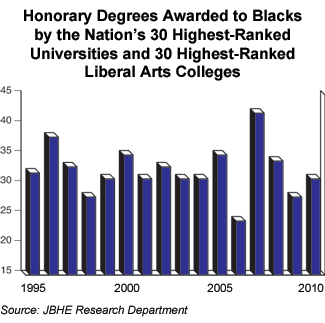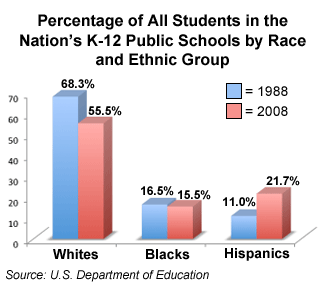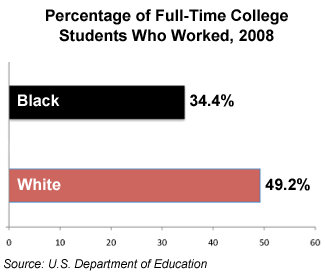Honorary Degrees Awarded to Blacks at This Spring’s Commencement Ceremonies of the Nation’s Highest-Ranked Universities
This spring the nation’s 30 highest-ranked universities and 30 highest-ranked liberal arts colleges bestowed honorary degrees on 30 blacks. This is one more than in 2009. The number of honorary degrees awarded to blacks peaked in 2007 when 44 were awarded. The lowest number of honorary degrees awarded to blacks by our top colleges and universities in the 16 years JBHE has tracked these awards was 24 in 2006.

Of the 30 honorary degrees awarded this year, 17 were given out by leading universities. Here is the list of high-ranking universities and their honorees:
• Brown University: Nelson Mandela, former president of South Africa, and Morgan Freeman, actor
• Columbia University: Geoffrey Canada, founder of the Harlem Children’s Zone
• Dartmouth College: Regina Benjamin, surgeon general of the United States, and Agnes Binagwaho, permanent secretary of the Ministry of Health of Rwanda
• Emory University: Joseph Lowery, civil rights activist
• Harvard University: Freeman Hrabowski, president of the University of Maryland, Baltimore County
• Northwestern University: David Levering Lewis, the Julius Silver University Professor and professor of history at New York University, David Satcher, former surgeon general of the United States and currently director of The Satcher Health Leadership Institute at the Morehouse School of Medicine in Atlanta, and Claude M. Steele, the provost of Columbia University
• Princeton University: Olufunmilayo Olopade, professor at the University of Chicago and one of the nation’s leading experts on breast cancer research
• Tufts University: Ann Hobson Pilot, former principal harpist of the Boston Symphony Orchestra
• University of Michigan: Barack Obama, president of the United States
• University of North Carolina Chapel Hill: Patricia Timmons-Goodson, associate justice of the North Carolina Supreme Court
• University of Pennsylvania: Risa J. Lavisso-Mourey, president and CEO of the Robert Wood Johnson Foundation
• Wake Forest University: Kenneth Chenault, CEO of American Express
• Yale University: Aretha Franklin, recording artist, and Ellen Johnson Sirleaf, president of Liberia
The honorees from the nation’s leading liberal arts colleges will be listed in next week’s edition.
The Changing Racial Demographics of the Nation’s Public Schools
In 2008 African Americans made up 15.5 percent of all K-12 public school students in the United States. A decade earlier, in 1998, blacks were 17.2 percent of all K-12 students, the highest level in history. Twenty years earlier in 1988, blacks were 16.5 percent of all public school students.

The percentage of whites in the nation’s public school systems has dropped from 68.3 percent in 1988 to 55.5 percent in 2008. Hispanics made up 11 percent of all K-12 public school students in 1988. The latest figures show that Hispanics are 21.7 percent of all students.
Former President of Historically Black Alabama A&M University Loses Wrongful Termination Lawsuit
 By a unanimous vote, the Alabama Supreme Court affirmed the dismissal of a lawsuit filed by Robert R. Jennings, the former president of historically black Alabama A&M University. Dr. Jennings was dismissed by the university’s board of trustees in March 2008. The board alleged that Jennings had failed to follow university procedures in the hiring of an assistant and then paid the assistant for time spent away from campus. By a unanimous vote, the Alabama Supreme Court affirmed the dismissal of a lawsuit filed by Robert R. Jennings, the former president of historically black Alabama A&M University. Dr. Jennings was dismissed by the university’s board of trustees in March 2008. The board alleged that Jennings had failed to follow university procedures in the hiring of an assistant and then paid the assistant for time spent away from campus.
Jennings filed suit claiming that his firing violated the terms of his employment contract and that several members of the board of trustees were ineligible to participate in the vote to dismiss him. A lower court dismissed the lawsuit in March 2009.
Dr. Jennings is a graduate of Morehouse College and holds a master’s degree and an educational doctorate from Clark Atlanta University.
  |
7.3% Percentage of all full-time teachers in the nation’s public schools in 2000 who were black.
6.9% Percentage of all full-time teachers in the nation’s public schools in 2008 who were black.
source: U.S. Department of Education
|
Recent Books That May Be of Interest to African-American Scholars
 Each month, the JBHE Weekly Bulletin publishes a list of new books that may be of interest to our readers. Here is this month’s selection. Each month, the JBHE Weekly Bulletin publishes a list of new books that may be of interest to our readers. Here is this month’s selection.
• African American History Reconsidered by Pero Gaglo Dagbovie (University of Illinois Press)
• Agitations: Ideologies and Strategies in African American Politics by Kevin R. Anderson (University of Arkansas Press)
• Alabama in Africa: Booker T. Washington, the German Empire, and the Globalization of the New South by Andrew Zimmerman (Princeton University Press)
• August Wilson: Completing the Twentieth-Century Cycle edited by Alan Nadel (University of Iowa Press)
• Bayou Classic: The Grambling-Southern Football Rivalry by Thomas Aiello (Louisiana State University Press)
• Belonging in an Adopted World: Race, Identity, and Transnational Adoption by Barbara Yngvesson (University of Chicago Press)
• Black Rage in New Orleans: Police Brutality and African-American Activism From World War II to Hurricane Katrina by Leonard N. Moore (Louisiana State University Press)
• Blue Smoke: The Recorded Journey of Big Bill Broonzy by Roger House (Louisiana State University Press)
• Blues Music in the Sixties: A Story in Black and White by Ulrich Adelt (Rutgers University Press)
• Brown in Baltimore: School Desegregation and the Limits of Liberalism by Howell S. Baum (Cornell University Press)
• Catholics, Slaveholders, and the Dilemma of American Evangelicalism, 1835-1860 by W. Jason Wallace (University of Notre Dame Press)
• Citizens of a Christian Nation: Evangelical Missions and the Problem of Race in the Nineteenth Century by Derek Chang (University of Pennsylvania Press)
• Citizenship and Its Exclusions: A Classical, Constitutional, and Critical Race Critique by Ediberto Román (New York University Press)
• Diasporas in the New Media Age: Identity, Politics, and Community edited by Andoni Alonso and Pedro J. Oiarzabal (University of Nevada Press)
• Evangelicalism and the Politics of Reform in Northern Black Thought, 1776-1863 by Rita Roberts (Louisiana State University Press)
• Fly Away: The Great African-American Cultural Migrations by Peter M. Rutkoff and William B. Scott (Johns Hopkins University Press)
• Fugitive Justice: Runaways, Rescuers, and Slavery on Trial by Steven Lubet (Harvard University Press)
• How Their Living Outside America Affected Five African American Authors: Toward a Theory of Expatriate Literature by Ewa Barbara Luczak (Edwin Mellen Press)
• In the Shadow of the Black Beast: African American Masculinity in the Harlem and Southern Renaissance by Andrew B. Leiter (Louisiana State University Press)
• Jim Crow’s Counterculture: The Blues and Black Southerners, 1890-1945 by R. A. Lawson (Louisiana State University Press)
• John Oliver Killens: A Life of Black Literary Activism by Keith Gilyard (University of Georgia Press)
• Making Gumbo in the University by Rupert W. Nacoste (Plain View Press)
• Moses of South Carolina: A Jewish Scalawag During Radical Reconstruction by Benjamin Ginsberg (Johns Hopkins University Press)
• Nassau Plantation: The Evolution of a Texas German Slave Plantation by James C. Kearney (University of North Texas Press)
• Navigating the Africa Diaspora: The Anthropology of Invisibility by Donald Martin Carter (University of Minnesota Press)
• One Story of Academia: Race Lines and the Rhetoric of Distinction Through the Academie Française by Moussa Traoré (Peter Lang Publishing)
• Partly Colored: Asian Americans and Racial Anomaly in the Segregated South by Leslie Bow (New York University Press)
• Race, Nation, and West Indian Immigration to Honduras, 1890-1940 by Glenn A. Chambers (Louisiana State University Press)
• Race, Trauma, and Home in the Novels of Toni Morrison by Evelyn Jaffe Schreiber (Louisiana State University Press)
• Raymond Pace Alexander: A New Negro Lawyer Fights for Civil Rights in Philadelphia by David A. Canton (University Press of Mississippi)
• Seeing Patients: Unconscious Bias in Health Care by Augustus A. White III with David Chanoff (Harvard University Press)
• Signs of the Times: The Visual Politics of Jim Crow by Elizabeth Abel (University of California Press)
• Slave Life in Virginia and Kentucky: A Narrative by Francis Fedric, Escaped Slave edited by C.L. Innes (Louisiana State University Press)
• Slavery, Civil War, and Salvation: African American Slaves and Christianity, 1830-1870 by Daniel L. Fountain (Louisiana State University Press)
• Something Akin to Freedom: The Choice of Bondage in Narratives by African American Women by Stephanie Li (State University of New York Press)
• Spirit of Rebellion: Labor and Religion in the New Cotton South by Jarod Roll (University of Illinois Press)
• Suffering Childhood in Early America: Violence, Race, and the Making of the Child Victim by Anna Mae Duane (University of Georgia Press)
• The Christian Imagination: Theology and the Origins of Race by Willie James Jennings (Yale University Press)
• The Colors of Zion: Blacks, Jews, and Irish From 1845 to 1945 by George Bornstein (Harvard University Press)
• The Diary of Antera Duke: An Eighteenth-Century African Slave Trader by Stephen D. Behrendt (Oxford University Press)
• The Fabulous George Lewis Band: The Inside Story by Barry Martyn and Nick Gagliano (Louisiana State University Press)
• The Good Men Who Won the War: Army of the Cumberland Veterans and Emancipation Memory by Robert Hunt (University of Alabama Press)
• The State of the African American Male edited by Eboni M. Zamani-Galaher and Vernon C. Polite (Michigan State University Press)
• Walls: Essays, 1985-1990 by Kenneth A. McClane (University of Notre Dame Press)
• What Was African American Literature? by Kenneth W. Warren (Harvard University Press)
• Why Race and Culture Matter in Schools: Closing the Achievement Gap in America’s Classrooms by Tyrone C. Howard (Teachers College Press)
• Writing Blackness: John Edgar Wideman’s Art and Experimentation by James W. Coleman (Louisiana State University Press)
|

White College Students Are Significantly More Likely Than Their African-American Peers to Work While Enrolled in Higher Education
The U.S. Department of Education reports that in 2008, 34.4 percent of black full-time college students were employed. More than 26 percent of all African-American full-time college students also worked for more than 20 hours per week. Nearly 70 percent of black students who were part-time students were employed and 40 percent of black part-time college students worked 35 or more hours per week.

White college students were significantly more likely than African-American college students to work. Nearly one half of all white full-time students also held a job and nearly a third worked more than 20 hours per week. A full 84 percent of white part-time college students held a job and 46.1 percent worked 35 or more hours per week.
  |
 “We know royalty when we see it, and you are, without question, the Queen of Soul. With the greatest R-E-S-P-E-C-T, we name you Doctor of Laws.” “We know royalty when we see it, and you are, without question, the Queen of Soul. With the greatest R-E-S-P-E-C-T, we name you Doctor of Laws.”
— from the honorary degree citation for Aretha Franklin from Yale University (See story to the left.)
|
Historically Black Medical Schools Ranked High in “Social Mission” Criteria
 A new study published in the Annals of Internal Medicine states that by 2020 the United States will face a shortage of 100,000 primary care physicians. And the study maintains that many of the nation’s leading medical schools are doing a poor job in turning out physicians who specialize in primary care. The report ranks the nation’s medical schools on the neighborhoods in which their graduates went on to practice medicine and the type of medicine that was practiced. The nation’s three historically black medical schools — Morehouse, Howard, and Meharry — were the highest-ranked institutions in graduating doctors who became primary care physicians in the nation’s most underserved areas. Vanderbilt University ranked last among the 141 medical schools in the survey. A new study published in the Annals of Internal Medicine states that by 2020 the United States will face a shortage of 100,000 primary care physicians. And the study maintains that many of the nation’s leading medical schools are doing a poor job in turning out physicians who specialize in primary care. The report ranks the nation’s medical schools on the neighborhoods in which their graduates went on to practice medicine and the type of medicine that was practiced. The nation’s three historically black medical schools — Morehouse, Howard, and Meharry — were the highest-ranked institutions in graduating doctors who became primary care physicians in the nation’s most underserved areas. Vanderbilt University ranked last among the 141 medical schools in the survey.
Historic Bust of Richard Allen Now On Display in Philadelphia
 Late last month a bust of Richard Allen, the founder of the African Methodist Episcopal Church, was placed on display at AME headquarters in Philadelphia. The bust was created for the 1876 Centennial Exhibition in Philadelphia and was briefly displayed there. AME officials wanted the bust to become a permanent memorial to Allen in the city’s Fairmount Park. But city officials refused. Late last month a bust of Richard Allen, the founder of the African Methodist Episcopal Church, was placed on display at AME headquarters in Philadelphia. The bust was created for the 1876 Centennial Exhibition in Philadelphia and was briefly displayed there. AME officials wanted the bust to become a permanent memorial to Allen in the city’s Fairmount Park. But city officials refused.
The bust was then shipped to Wilberforce University in Ohio, where it sat in storage and was largely forgotten. After a tornado ravaged the Wilberforce campus in the 1970s, someone placed the bust on the reference desk at the university library. But it was many years before the origins of the bust became known, largely through the efforts of Susanna Gold, an assistant professor of art history at Temple University.
The bust will be displayed at the Richard Allen Museum at the Mother Bethel AME Church in Philadelphia for at least the next year.
Huge Racial Disparities Persist in High School Graduation Rates
 A new study by the Editorial Projects in Education Research Center finds that 53.7 percent of black students who were enrolled in ninth grade in 2003 went on to graduate from high school in 2007. This figure was significantly below the high school graduation rate for white students, which stood at 76.6 percent. A new study by the Editorial Projects in Education Research Center finds that 53.7 percent of black students who were enrolled in ninth grade in 2003 went on to graduate from high school in 2007. This figure was significantly below the high school graduation rate for white students, which stood at 76.6 percent.
The highest black student high school graduation rate was in the state of Arizona. More than 69 percent of black students in Arizona successfully completed their high school education. However, a racial gap still persists in the state. More than 74 percent of white students earned their high school diploma.
Other states with high graduation rates for black students were Colorado, Idaho, Maine, New Jersey, and Rhode Island.
The lowest black high school graduation rate was in the state of Vermont. There, only 30.2 percent of black students earned their high school diploma. In Nevada, 30.7 percent of black students graduated from high school.
Other states where blacks were the least likely to graduate from high school were Alaska, Montana, Nebraska, and South Carolina.
The states with the smallest racial disparity in high school graduation rates include Hawaii, Arizona, Tennessee, Mississippi, and West Virginia.
In Pennsylvania, Ohio, Montana, Nebraska, Vermont, and Wisconsin, the black student graduation rate was at least 30 percent lower than the rate for white students.
Black Man Defeats Son of Strom Thurmond for GOP Nomination in South Carolina’s Second Congressional District
 Last Tuesday, Tim Scott defeated the son of former senator Strom Thurmond for the GOP nomination for the U.S. House of Representatives for South Carolina’s First Congressional District. The district is a Republican stronghold so Scott is expected to win the general election. He will be the first African-American Republican elected to the House from the Deep South since Reconstruction. Last Tuesday, Tim Scott defeated the son of former senator Strom Thurmond for the GOP nomination for the U.S. House of Representatives for South Carolina’s First Congressional District. The district is a Republican stronghold so Scott is expected to win the general election. He will be the first African-American Republican elected to the House from the Deep South since Reconstruction.
Scott is a 1988 graduate of Charleston Southern University and served a five-year term on the university’s board of visitors from 2003 to 2008. He served for 13 years on the Charleston County Council before being elected to the South Carolina House of Representatives.
Scott is a tried and true conservative. He was endorsed by Mike Huckabee and Sarah Palin.
In his remarks following his nomination victory, Scott said, “The relevance of me being black is really, fortunately irrelevant.”
Appointments, Promotions, and Resignations
 • Mark A. Kidd was appointed dean of students at the Manassas campus of Northern Virginia Community College. He was associate dean of university life at George Mason University in Fairfax, Virginia. • Mark A. Kidd was appointed dean of students at the Manassas campus of Northern Virginia Community College. He was associate dean of university life at George Mason University in Fairfax, Virginia.
Dean Kidd holds a bachelor’s degree and an MBA from the University of Southern Mississippi and a Ph.D. from the University of Mississippi.
 • Andriel Dees was named chief diversity officer at the University of Wisconsin-River Falls. She was associate dean for multicultural affairs at the William Mitchell College of Law in St. Paul, Minnesota. • Andriel Dees was named chief diversity officer at the University of Wisconsin-River Falls. She was associate dean for multicultural affairs at the William Mitchell College of Law in St. Paul, Minnesota.
Dees is a graduate of Hampton University and the William Mitchell College of Law.
 • Charles P. Mouton was named dean of the School of Medicine at Meharry Medical College. He was professor and chair of the department of community and family medicine at Howard University. • Charles P. Mouton was named dean of the School of Medicine at Meharry Medical College. He was professor and chair of the department of community and family medicine at Howard University.
 • Latrice C. Pichon was named assistant professor in the division of social and behavioral sciences at the University of Memphis School of Public Health. She has been doing postdoctoral research as a Kellogg Health Scholar at the University of Michigan. • Latrice C. Pichon was named assistant professor in the division of social and behavioral sciences at the University of Memphis School of Public Health. She has been doing postdoctoral research as a Kellogg Health Scholar at the University of Michigan.
Dr. Pichon is a graduate of Xavier University of Louisiana. She holds a master’s degree from San Diego State University and earned a Ph.D. in the joint public health program at San Diego State and the University of California at San Diego.
 • Selwyn R. Cudjoe, chair of the Africana studies department at Wellesley College in Massachusetts, was appointed Margaret E. Deffenbaugh and LeRoy T. Carlson Professor in Comparative Literature at the college. Professor Cudjoe, a native of Trinidad, has taught at Wellesley College since 1986. • Selwyn R. Cudjoe, chair of the Africana studies department at Wellesley College in Massachusetts, was appointed Margaret E. Deffenbaugh and LeRoy T. Carlson Professor in Comparative Literature at the college. Professor Cudjoe, a native of Trinidad, has taught at Wellesley College since 1986.
Dr. Cudjoe holds bachelor’s and master’s degrees from Fordham University and a Ph.D. in American literature from Cornell University.
 • Cynthia Jackson-Hammond was named provost and vice president of academic affairs at Coppin State University in Baltimore. She was dean of the School of Education and Human Performance at Winston-Salem State University in North Carolina. • Cynthia Jackson-Hammond was named provost and vice president of academic affairs at Coppin State University in Baltimore. She was dean of the School of Education and Human Performance at Winston-Salem State University in North Carolina.
Dr. Jackson-Hammond is a graduate of Grambling State University. She holds a master’s degree in education from the University of Louisiana at Monroe and a doctorate in education from Grambling.
 • Reginald Van Lee, executive vice president of Booz Allen Hamilton, was elected to the board of the MIT Corporation. Lee holds bachelor’s and master’s degrees from MIT and an MBA from the Harvard Business School. • Reginald Van Lee, executive vice president of Booz Allen Hamilton, was elected to the board of the MIT Corporation. Lee holds bachelor’s and master’s degrees from MIT and an MBA from the Harvard Business School.
Honors and Awards
 • Cheryl S. Taylor, director of nursing research at Southern University in Baton Rouge, Louisiana, is the inaugural recipient of the Dr. Cheryl Taylor Award for Leadership and Vision established by the Centers for Disease Control’s Racial and Ethnic Approaches to Community Health (REACH) program. • Cheryl S. Taylor, director of nursing research at Southern University in Baton Rouge, Louisiana, is the inaugural recipient of the Dr. Cheryl Taylor Award for Leadership and Vision established by the Centers for Disease Control’s Racial and Ethnic Approaches to Community Health (REACH) program.
Dr. Taylor earned her bachelor’s of science degree in nursing from Dillard University of New Orleans. She holds a master’s degree in systems-oriented community mental health nursing from the University of Washington at Seattle and a Ph.D. in nursing from Texas Woman’s University.
 • Neal Lester, professor of English at Arizona State University in Tempe, received the David Bottoms Distinguished Alumni Award from the University of West Georgia. • Neal Lester, professor of English at Arizona State University in Tempe, received the David Bottoms Distinguished Alumni Award from the University of West Georgia.
Professor Lester holds a bachelor’s degree from the University of West Georgia and a Ph.D. in English from Vanderbilt University.
 • Kofi Adu-Nyako, associate professor of applied economics in the School of Agriculture and Environmental Sciences at North Carolina A&T State University in Greensboro, received the 2010 Research Award from Get Healthy Guilford for “his significant contributions to the understanding of obesity.” • Kofi Adu-Nyako, associate professor of applied economics in the School of Agriculture and Environmental Sciences at North Carolina A&T State University in Greensboro, received the 2010 Research Award from Get Healthy Guilford for “his significant contributions to the understanding of obesity.”
 • Virginia State University has renamed the Gateway Residence Hall in honor of retiring president Eddie N. Moore Jr. and his wife Elisia. The facility, which houses 500 students, was opened in August 2008. • Virginia State University has renamed the Gateway Residence Hall in honor of retiring president Eddie N. Moore Jr. and his wife Elisia. The facility, which houses 500 students, was opened in August 2008.
 • Herbert J. Hancock received the 2010 Alumni Award from Grinnell College. Herbie Hancock, one of the nation’s most celebrated jazz musicians, was a 1960 graduate of Grinnell College. • Herbert J. Hancock received the 2010 Alumni Award from Grinnell College. Herbie Hancock, one of the nation’s most celebrated jazz musicians, was a 1960 graduate of Grinnell College.
 • Shiriki Kumanyika, professor of epidemiology at the University of Pennsylvania School of Medicine, received the individual recognition award from the College of Physicians of Philadelphia. She was recognized for her leadership role in the organization Healthy People 2020. • Shiriki Kumanyika, professor of epidemiology at the University of Pennsylvania School of Medicine, received the individual recognition award from the College of Physicians of Philadelphia. She was recognized for her leadership role in the organization Healthy People 2020.
Dr. Kumanyika is a graduate of Syracuse University. She holds a master of science degree in social work from Columbia University, a master of public health degree from Johns Hopkins University, and a Ph.D. in human nutrition from Cornell University.
Grants and Gifts
• The University of the Virgin Islands, a historically black educational institution in St. Thomas, received a $1 million donation from S. Donald Sussman, a trustee of the university. The money will be used to help fund the construction of a new science center on campus.
• Meharry Medical College, the historically black educational institution in Nashville, received a five-year, $2 million grant from the Centers for Disease Control and Prevention. The money will fund an AIDS/HIV prevention program throughout the Nashville metropolitan area.
• Dillard University, the historically black educational institution in New Orleans, will share a $6.5 million grant from the National Institutes of Health with the Louisiana State University Health Sciences Center. The grant money will fund research into possible genetic factors that produce racial disparities in certain cancers.
• New York Medical College received a $100,000 grant from the Hearst Foundation for an endowed scholarship fund for minority students.
|